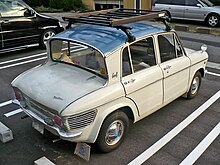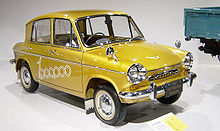Mazda Carol P360
The Mazda Carol P360 / P600 was a sedan in the Japanese kei car class and was first presented in 1962. The model was based on Mazda's first car model, the Mazda R360, and expanded this two-seater coupé in the model range. As early as 1964, the Carol P600 sedan was replaced by the Mazda 800 Familia. The Carol P360 sedan was built until 1970 and was replaced by the Mazda Chantez in 1972 .
| Mazda | |
|---|---|
|
Mazda Carol P360
|
|
| Carol P360 / P600 | |
| Sales designation: | Carol P360 / P600 |
| Production period: | 1962-1970 1962-1964 |
| Class : | Microcar |
| Body versions : | limousine |
| Engines: |
Petrol engines : 0.36–0.59 liters (10–36 kW) |
| Length: | 2980 mm |
| Width: | 1295 mm |
| Height: | 1340 mm |
| Wheelbase : | 1930 mm |
| Empty weight : | from 525 kg |
| successor | Mazda 800 (Carol P600), Mazda Chantez |
Mazda Carol P360 1962-1970
Toyo Kogyo, now Mazda , entered the passenger car market in 1960 with the two-seat Mazda R360 coupe . Although the model was cheaper than the Subaru 360 from the main competitor at the time, Subaru, it offered four seats and was otherwise superior in terms of function, since the engine in the Mazda was only an air-cooled two-cylinder V-engine. Mazda developed a competitive model under the project name Carol , which was presented at the 1961 Tokyo Motor Show as a prototype of the Mazda 700 sedan with a 700 cc engine. The study was well received and Mazda decided to develop it further as a small car with a 360 cc petrol engine. As with the R360, the outwardly inclined rear window was located directly behind the rear seat backrest, resulting in good headroom in a small space and at the same time a rear that was designed as variably as possible. The water-cooled four-stroke gasoline engine with 360 cm³ displacement, four cylinders, hanging valves and aluminum housing was located in the rear and drove the rear wheels. The cooling air was supplied through a side opening with the aid of a fan driven by the motor and flowed off to the rear. All wheels were individually suspended and had rubber springs. Because of the narrow width, the maximum of four passengers sat relatively cramped on the two bench seats. The 5-door deluxe sedan followed in 1963, but also only had the 360 cc engine and thus differed from the Carol P600.
The entire model series was initially a great sales success, but it did not come close to the market leader in the segment, the Subaru 360. This was mainly due to the low power for the weight of the vehicle and the narrow interior. As sales fell, the Deluxe Catch-up was created as a lower price model. In 1966 the Subaru 450 appeared, a 360 with a more powerful engine, and among other things the new Honda N360 . This revealed the Carol's weaknesses in terms of design, performance and space utilization. Nevertheless, they did not want to make a fundamental change to the Carol P360, which was meanwhile little profitable. Until then, Mazda had concentrated on the development of small cars with rotary engines , but these could not have been used successfully in the Carol. Thus, in 1966, they contented themselves with modernizing the rear, including the radiator grille, and improving engine performance. The trunk in the bow was expanded and the engine and the spare wheel were stored differently. However, nothing could be done about the general tightness of the car and the excessive weight. Thus the Carol P360 fell further and further back and was the worst-selling car in its last sales years.
Although there were originally plans for a rotary piston engine that was already being tested and used in higher classes, the as yet half-baked system was only approved for commercial vehicles. Mazda continued to develop it, however, mainly for a planned successor. However, after not all problems could be resolved by the originally planned start of production, the Carol P360 was discontinued in 1970. Mazda finally had to equip the successor Mazda Chantez with a two-stroke engine, because the competition and the authorities prevented the fully developed small 3A single Wankel engine. When the Chantez was launched in 1972, Mazda decided to stop developing engines for the kei-car class. After the Chantez was discontinued due to the changed emissions regulations in 1976, Mazda withdrew further from the kei car segment. There was only the Mazda Porter van , for which Mitsubishi Motors was now available . Only in 1989 did they return with the Autozam sub-brand and Autozam Carol .
Mazda Carol P600 1962-1964
In November 1962, the Carol P360 was followed by the Carol P600 four-door sedan. It was no longer a kei car, but with other bumpers and a length of 3200 mm should be an offer in the middle class. The interior was the same. Its RA type gasoline engine had a displacement of 586 cc and 28 hp (21 kW). A Carol P600 that rolled off the assembly line on March 9, 1963 was the millionth Mazda passenger car ever built. This vehicle, painted in gold metallic, is in the Mazda Museum. Due to the design, the P600 was the same tightness as in the P360, and the performance was lower than that of new and established competing vehicles, so that the model was replaced by the Mazda 800 when production of the Mazda Familia series began in 1964 . Around 8800 Carol 600 were built.


